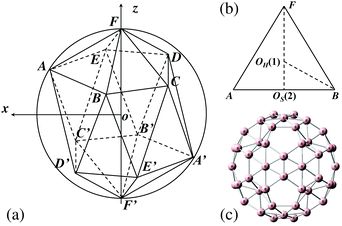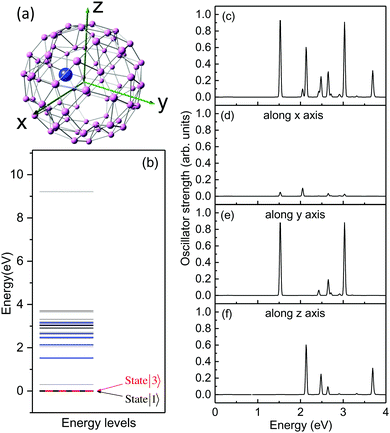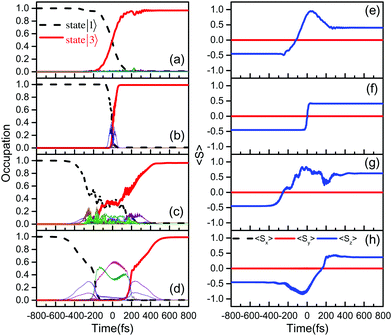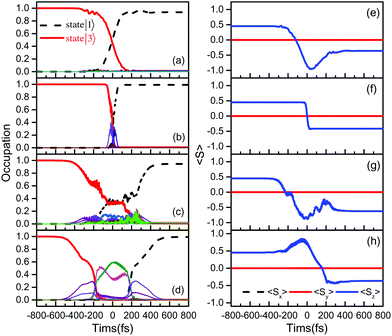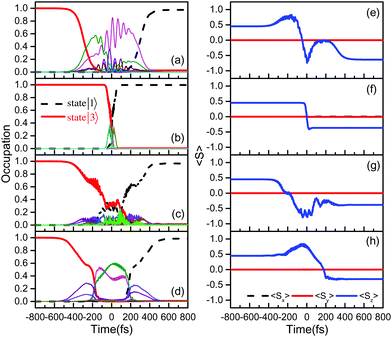 Open Access Article
Open Access ArticleCreative Commons Attribution 3.0 Unported Licence
Reversible ultrafast spin switching on Ni@B80 endohedral fullerene
Chun
Li
*a,
Jing
Liu
a,
Georgios
Lefkidis
ab and
Wolfgang
Hübner
b
aSchool of Mechanics, Civil Engineering and Architecture, Northwestern Polytechnical University, Xi'an 710072, China. E-mail: lichun@nwpu.edu.cn
bDepartment of Physics and Research Center OPTIMAS, University of Kaiserslautern, P. O. Box 3049, 67653 Kaiserslautern, Germany
First published on 22nd November 2016
Abstract
We present the configurations and stability of the endohedral metallofullerene Ni@B80 by using strict and elaborate geometric modeling. The ultrafast spin switching on Ni@B80 is explored through ab initio calculations. It is shown that there are three stable configurations of Ni@B80 endohedral fullerene with the encaged Ni atom located at different sites. The ultrafast spin switching on Ni@B80via Λ processes can be achieved through at least eight paths with different laser pulses. Among them, the fastest one can be accomplished within 100 fs. In particular, it is found that all the spin-switching processes achieved on the H-type structure are reversible with the use of the same or different laser pulses. Considering the obtained high fidelities of these switching processes, the present theoretical prediction could lead to promising applications in the design of integrated spin-logic devices through appropriate spin manipulation in endohedral boron fullerenes.
1 Introduction
In recent years, ultrafast spin dynamics on magnetic nanostructures has become an increasingly intensive research field in order to develop novel spin devices serving as a substitute for traditional electronic ones by manipulating the spin degree of freedom of specific systems. Since Bigot and his co-workers first discovered ultrafast magnetization in ferromagnetic metals in 1996,1 the ultrafast spin dynamics has made remarkable progress and has become relevant for a wide range of research areas and applications involving bulk materials, thin films, nanostructures, and molecular magnets in the past ten years.2–8As is typical for fullerene-based materials, endohedral fullerenes are characterized by a robust fullerene cage with atoms, ions, or clusters trapped in its hollow. Because of the electron transfer from the encaged species to the fullerene cage, such molecules open many possibilities for applications and have therefore been attracting wide interest in interdisciplinary research areas.9–13 Endohedral fullerenes can be conducive to spin manipulation because the fullerene cage can serve as a sheltering room for the inner spin system which prevents the desired dynamics from being disturbed by the external environment.14,15 In addition, the robustness of the structure and long coherence time of the electronic states give to these compounds great potential to serve as functional information carriers in future nano-spintronics applications.16 These excellent characteristics have drawn wide attention of scientists and given new impetus to the efforts toward the practical application and theoretical investigation of endohedral fullerenes. Harneit et al. explored the possibilities of using endohedral fullerenes N@C60 and P@C60 as quantum-information carriers.17 Ju et al. proposed a new scalable quantum computer architecture based on the nuclear spin manipulation on endohedral fullerene molecules.18 Li et al. proposed a theory for manipulating the spin degree of freedom in Co2C60.19,20 These investigations provide the background for designing fullerene-based spin-logic devices and also stimulate further theoretical and experimental studies in order to explore controllable ultrafast spin manipulations.
However, up to now most researchers have focused on the properties and applications of carbon fullerenes, while for a long time non-carbon fullerenes have drawn much less attention, due to the difficulties in their experimental synthesis. After Gonzalez et al. predicted a stable atomic arrangement of the fullerene B80 in 2007,21 boron fullerenes began to attract scientists' interest. B80 is believed to be a large soccer-like molecule with a wide hollow space inside (although a recent study using minimal-hopping global-geometry optimization predicts a multitude of stable structures22). The boron cage consists of 20 hexagons and 12 pentagons, and is structurally similar to C60 except that there are 20 additional boron atoms lying on the sites near the center of the hexagons.23–28 The quite large energy gap (almost 1 eV) between the highest occupied molecular orbital (HOMO) and the lowest unoccupied molecular orbital (LUMO) also furnishes a proof of the stability of B80.23,24,27 Because of this and its C60-like structure, scientists have also been motivated to find new stable configurations of endohedral B80 fullerenes. Recently, Wang et al. explored the structural stability of boron caged B@Co12@Bn and Co13@Bn clusters, and showed the desirable properties of B@Co12@B80, such as the large binding energy of the closed-shell electronic structure.24 Li et al. presented the geometric and magnetic properties of three stable configurations of Ni@B80 and Fe@B80.25,26 Interestingly, according to the investigation of Bean et al., the quite large and positive NICS (nucleus independent chemical shift) value suggests magnetic deshielding at various extra-nuclear points inside the B80 cages, which is opposite to the inner space of C60 cages.29 This property indicates the spin manipulation on inner magnetic atoms of endohedral boron fullerenes by applying an external magnetic field. Experimentally, several endohedral boron fullerenes have already been synthesized30,31 and their stability has also been investigated.32,33 In addition, there are other theoretical groups investigating the newly established field of endohedral boron-fullerenes.34–36 However, to the best of our knowledge, the study of the spin dynamics in endohedral boron fullerenes, which is indispensable before exploiting them in future nano-spintronic devices, has not been reported yet.
In this paper, the laser-induced ultrafast spin-switching mechanism of Ni@B80 is systematically investigated by combining high-level ab initio calculations with the well-developed theoretical framework of spin-switching Λ processes. The geometry and the spin density distribution of the system are also studied in depth. Three stable configurations of Ni@B80 are found, which can be identified by the location of the Ni atoms in the boron cage. In addition, several subpicosecond spin-switching scenarios on Ni@B80 are proposed, with the fastest one completing within only 100 fs. It is noteworthy, that some of the spin switching scenarios can be achieved with more than one set of laser parameters, thus rendering them experimentally easier to realize.
2 Modeling and technique details
2.1 Structure construction and optimization
In order to properly describe the spin-dynamics behavior of Ni@B80 endohedral fullerene, we first have to determine the geometry of Ni@B80. Ni@B80 can be divided into three parts: a C60-like cluster B60, additional 20 boron atoms located near the center of hexagons, and an isolated Ni atom. The model of B60 is built firstly referring to the geometry modelling of C60.37 The built B60 forms the basic frame of the whole fullerene molecule and plots out the initial areas for the other atoms. Due to their geometric similarity we hypothesize that both C60 and B80 have the same icosahedral symmetry (point group Ih). The structure can be formed by equally removing 12 vertices of the regular icosahedron. As shown in Fig. 1(a), vertex F is sitting on the z axis, which is also the 5-fold axis of the icosahedron. The coordinates of point F are (0,0,R). Point A is located on the plane xoz, a mirror plane of the icosahedron. Therefore, the coordinates of point A are assumed to be (a,0,c). Since both F and A are on the surface of the circumscribed sphere of the regular icosahedron, it is easy to demonstrate that .
.
The coordinates of points B, C, D, and F, can be obtained by  rotations of point A around the z axis. The respective position vectors are
rotations of point A around the z axis. The respective position vectors are
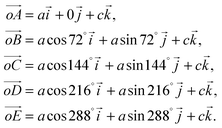 | (1) |
In order to calculate the 60 coordinates of each boron atoms of the B60 cluster, 20 identical pentagonal pyramids are removed from the vertices of the icosahedron, and a new parameter λ is defined as the ratio of the intercepted length to the initial length of the edge. For example, there will be two additional points b1(1) and b2(1) on the line AF, after removing the two pentagonal pyramids corresponding to points A and F. In other words, b1(1) and b2(1) are the positions of two boron atoms of a B60 cluster, and their position vectors can be expressed as
 | (2) |
 | (3) |
 rotation around the z axis, and (ii) inversion through the origin o.
rotation around the z axis, and (ii) inversion through the origin o.
The three unknown constants a, c and λ, with the value of the known bond length and the mathematical relationship between the known parameters and the unknowns, can be found from the following equations:
 | (4) |
 | (5) |
 | (6) |
 | (7) |
For the additional 20 boron atoms sitting on the sites close to the centers of hexagons, we first assume that there are no irregularities on the surface of the boron cage, and that these atoms are located exactly at the centers of the hexagons. Therefore, the initial coordinates of boron atoms directly correspond to the coordinates of the centers of the hexagons (obviously the centers of the hexagons are also the centroids of the 20 triangular faces of the icosahedron). To locate these additional boron atoms, we take the centroid of ΔABF named OH(1) as a basis, as shown in Fig. 1(b), and write its position vector as follows:
 | (8) |
The centroid of ΔABD′, referred to as OH(2), cannot be reached by any symmetry operations of OH(1), therefore this point is also part of the basis. Using the coordinates of points A, B, and D′, the position vector of OH(2) can be expressed as
 | (9) |
Through the previously mentioned symmetry operations, the coordinates of the remaining 18 boron atoms can be easily calculated as well. Fig. 1(c) depicts the starting, perfectly symmetric geometry constructed with these considerations.
We optimize the starting geometry of B80 using the Gaussian 09 package38 with the restricted open shell Hartree–Fock (ROHF) method (in order to avoid spin contamination). We employ four geometry convergence criteria: (i) the maximum component of the force must be below the cutoff value of 4.5 × 10−4 Hartree Bohr−1, (ii) the root-mean-square of the forces must be below 3.0 × 10−4 Hartree Bohr−1, (iii) the calculated displacement for the next step must be kept below 1.8 × 10−3 Bohr, and (iv) the root-mean-square of the displacement for the next step must be smaller than the cutoff value of 1.2 × 10−3. Finally, we place the Ni atom into the inner hollow area of the optimized B80 cage and re-optimize the whole structure. The stability of the final optimized geometry is verified by the absence of imaginary normal-mode frequencies.
2.2 Computational method for spin switching
In the past, we have presented several ultrafast laser-induced magnetization-dynamics scenarios on various bare as well as ligand-stabilized molecular systems.39–43 In particular, by taking advantage of suitable Λ processes one can realize four different scenarios: (1) (partial) demagnetization, (2) spin switching, (3) spin transfer, and (4) simultaneous spin switching and spin transfer.44 The improved processes proposed in the manuscript are also based on optical transitions and driven by a coherent laser field between the ground states (initial and final states) and other well-defined electronic excited states (intermediate states) of our magnetic system.The one-electron wave functions are obtained with the Hartree–Fock method using the STO-3G basis set for the B atoms and the Los Alamos basis set (LanL2DZ)45 plus double ζ with relativistic effective core potentials (ECP) for the Ni atom (these basis sets have proven successful on numerous strongly correlated materials and endohedral fullerene systems before19,20,41,46). This is also the level at which we perform the geometry optimization. Then, the electronic correlations are included by the symmetry-adapted-cluster configuration-interaction (SAC-CI) method47 and the many-body electron wave functions are obtained, as implemented in the Gaussian 09 package.38 In order to achieve high numerical accuracy at a realistic computational cost, we repeat the SAC-CI calculations twice. The first time, in which we allow only for singles virtual excitations, is used to deduce the necessary active window. This window comprises 196 molecular orbitals and is capable of accounting for the correlated d–d transitions of the Ni atom. The second time we allow up to quadruple one-electron virtual excitations.
Subsequently, we perturbatively include spin–orbit coupling (SOC) and a static external magnetic field along the z direction (Bstat. = 10−5 at. un. = 2.35 T) in order to obtain the Zeeman splitting and the necessary spin-mixed states.41,43 The corresponding Hamiltonian is
 | (10) |
![[L with combining circumflex]](https://www.rsc.org/images/entities/b_char_004c_0302.gif) and Ŝ are the orbital and spin momentum operators, respectively. μL and μS are their respective gyromagnetic ratios, and c is the speed of light. After including the SOC and the external magnetic field, the transition matrix elements of the electric-dipole-transition operator
and Ŝ are the orbital and spin momentum operators, respectively. μL and μS are their respective gyromagnetic ratios, and c is the speed of light. After including the SOC and the external magnetic field, the transition matrix elements of the electric-dipole-transition operator ![[D with combining circumflex]](https://www.rsc.org/images/entities/b_char_0044_0302.gif) and the spin momentum operator Ŝ are calculated for every many-body-state pair. Finally, by using time-dependent perturbation theory, the wave function is propagated in time under the influence of a suitably tailored laser pulse with a simple sech2-shaped envelope. The interaction between the aforementioned transition matrix and the laser pulse gives the time-dependent perturbation term in the Hamiltonian. The propagation of the many-body wave functions can be described as the following equation,
and the spin momentum operator Ŝ are calculated for every many-body-state pair. Finally, by using time-dependent perturbation theory, the wave function is propagated in time under the influence of a suitably tailored laser pulse with a simple sech2-shaped envelope. The interaction between the aforementioned transition matrix and the laser pulse gives the time-dependent perturbation term in the Hamiltonian. The propagation of the many-body wave functions can be described as the following equation, | (11) |
 , and En and Ek are the energies of states n and k, respectively. In order to solve the system of these partial differential equations, we implement our own codes, which use an embedded fifth-order Runge–Kutta method in combination with the Cash–Karp adaptive step-size control. This way, the complete time evolution of the Λ process can be obtained. The optimization of laser parameters is performed using a specially developed genetic algorithm.48
, and En and Ek are the energies of states n and k, respectively. In order to solve the system of these partial differential equations, we implement our own codes, which use an embedded fifth-order Runge–Kutta method in combination with the Cash–Karp adaptive step-size control. This way, the complete time evolution of the Λ process can be obtained. The optimization of laser parameters is performed using a specially developed genetic algorithm.48
3 Results and discussions
3.1 Structural analysis
The optimization yields three stable geometries for Ni@B80 (Fig. 2): (i) the Ni atom sits near the center of a hexagon (H type); (ii) the Ni atom sits near the vertex of a pentagon (Pv type); (iii) the Ni atom sits near the midpoint of the B–B bond between two opposite hexagons (HH type). As discussed previously, the B–B bonds can be divided into three groups: 60 between pentagons and hexagons (LHP), 30 between two neighboring hexagons (LHH), and 120 between the atoms at the center of each hexagon and their nearest neighbors (LBB).25 The average bond lengths of the three groups in the present study (1.74, 1.63, and 1.73 Å, respectively) are similar to the previous density-functional calculations (1.74, 1.70, and 1.73 Å, respectively25). The distances between the Ni atom and the center of the boron cage are 1.747 Å (H type), 1.771 Å (Pv type) and 2.113 Å (HH type), respectively. Each structure exhibits a slight Jahn–Teller distortion in the vicinity of the Ni atom.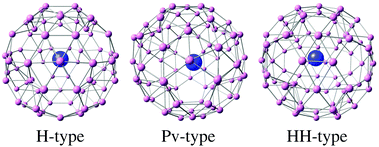 | ||
| Fig. 2 Three optimized configurations of endohedral metallofullerene Ni@B80. The red spheres denote boron atoms and the blue ones represent the Ni atom. | ||
Note that out of the 20 additional boron atoms initially positioned in the center of the hexagons of B60, 8 move inward and 12 move outward, and thus the final symmetry of B80 is reduced to Th [Fig. 1(c)].
In order to further ascertain the stability of the optimized geometries, we also look into the total binding energy of Ni@B80, given as Ebind. = EB80 + ENi − Etot., where EB80, ENi, and Etot. are the total energies of the isolated B80, an isolated Ni atom, and the endohedral metallofullerene Ni@B80, respectively (Table 1). In the rest of the manuscript we discuss the H-type configuration, which has the largest binding energy. In addition, we calculate the HOMO–LUMO energy gap of the magnetic system by applying HF and SAC-CI methods. The quite large resulting value (2.465 eV) also explains the stability of Ni@B80. In addition, Fig. 3 shows the HOMO and LUMO of Ni@B80 as they are obtained from the Hartree–Fock calculations. According to our SAC-CI calculations, the LUMO makes a major contribution to the vast majority of the virtual excitations which constitute the correlations in the many-body wavefunctions. This results in a very strong interaction between the cage and the central Ni atom, which clearly explains the connection between spin localization and geometry.
| Type | E Ni (eV) | E B80 (eV) | E tot. (eV) | E bind. (eV) |
|---|---|---|---|---|
| H | −57573.589 | 3.414 | ||
| HH | −4577.34 | −52992.835 | −57573.347 | 3.172 |
| Pv | −57570.175 | 1.179 |
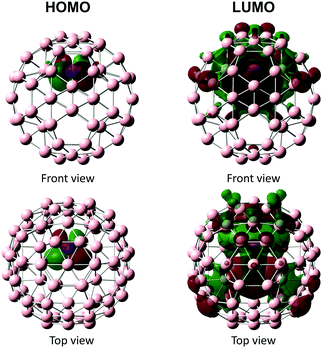 | ||
| Fig. 3 The HOMO and LUMO of Ni@B80. The isosurfaces of the wavefunctions are red and green for positive and negative values, respectively. The isovalue is 0.02. | ||
3.2 Spin-switching processes on Ni@B80
The spin density (calculated using Mulliken population analysis) reveals that, as anticipated, the greatest part of the spin density of the energetically lowest triplet states is localized on the enclosed Ni atom (Table 2). This is a necessary condition in order to exploit Ni@B80 for spin manipulation. Furthermore, the degree of spin localization of the triplet ground state is higher in the most stable geometry (H type), while the boron cage has the lowest spin polarization (in other words, the spin density of the cage is almost equally distributed among the boron atoms). These observations further corroborate our choice of the H-type geometry as the best candidate for spin-manipulation.| Type | Atom | State 1 | State 2 | State 3 | State 4 | State 5 |
|---|---|---|---|---|---|---|
| H | Ni | 1.591 | 0.982 | 0.983 | 0.978 | 0.963 |
| B(max) | 0.021 | 0.056 | 0.059 | 0.064 | 0.043 | |
| HH | Ni | 0.983 | 0.983 | 1.101 | 1.037 | 0.989 |
| B(max) | 0.191 | 0.171 | 0.090 | 0.060 | 0.096 | |
| Pv | Ni | 1.110 | 0.949 | 0.942 | 0.934 | 0.890 |
| B(max) | 0.230 | 0.120 | 0.108 | 0.171 | 0.165 | |
To achieve Λ-process-based spin-switching on the H-type Ni@B80, we need two ground states as the initial and final states, and some spin-mixed intermediate state(s). In particular, an initial intermediate state needs to be chosen first as an initial condition for the genetic algorithm. Previous theoretical work has established that the energy difference between the ground and spin-mixed intermediate states must be neither too small nor too large, with optimal values between 1 to 1.5 eV (so that optical transitions are facilitated but the spin-mixed intermediate states remain individually addressable41). A similar criterion holds for the energy difference between the initial and the final states: it should be neither too small (so that the two states are distinguishable) nor too big (otherwise the Λ process becomes inefficient and at the same time direct relaxation processes shorten the life-time of the energetically higher one). Here, an optimal value is around 1 cm−1 (≈1.2 × 10−4 eV). Therefore, the two almost degenerate ground states with opposite spin directions that originate from the same triplet state are the best choice. As for the intermediate states, they should be states in which a spin-up and a spin-down are mixed due to SOC, or the spin-switching process could be a spin forbidden process. This is a prerequisite for the spin-switching Λ processes.
Fig. 4(b) shows some of the lowest energy levels of the H-type Ni@B80 molecule with SOC and the transition information of the states involved in the spin dynamics. We select states |1〉 and |3〉 as the initial and final states, respectively, of a Λ process since they originate from the triplet ground state with opposite spin orientations and the splitting energy is about 0.058 eV, which fulfill the aforementioned energy requirement. The energy peaks of the optical spectrum in Fig. 4(c) propose some possible candidates for the initial intermediate states in the energy interval from 1.53 to 3.69 eV, which correspond to states |7〉, |9〉, |13〉, |19〉, |21〉, |26〉, |37〉, |39〉, |55〉 (shown as blue solid lines in Fig. 4(b)). Comparing the projected optical absorption spectra (Fig. 4(d)–(f)), we find that the oscillator strength along the y and z axes contribute most to the total oscillation spectra, while the oscillator strength along the x axis is very weak, which can be even neglected with respect to the oscillator strength along the y and z directions. In addition, the intense peaks in the y- and z-projected optical spectra are observed in different energy intervals (1.53 to 3.032 eV for the y-projected optical spectra, and 2.13 to 3.69 eV for the z-projected optical spectra). This phenomenon indicates that there could be more than one path for achieving the spin switching process and polarization orientation of the corresponding laser pulse. And finally, our genetic algorithm yields successful spin flip scenarios for the initial intermediate states |12〉, |19〉, |25〉, and |37〉, accounting for four different processes (for the sake of clarity, the corresponding switching processes are labeled as Λ12, Λ19, Λ25, and Λ37, respectively).
All the spin-switching processes can be achieved within the picosecond time regime and all population-transfer fidelities are larger than 0.95 (Fig. 5). Although the four achieved switching processes have the same initial and final states, the details of the population transfer processes are very different. For instance, it takes almost 1 ps for Λ37 to finish and 800 fs for Λ19 or Λ25. Λ12 is by far the fastest, it completes within 100 fs. In addition, the |1〉 → |3〉 switch necessitates several Rabi-like cycles through processes Λ25 and Λ37, while the other two processes are much smoother. The number of the involved intermediate states also varies with each process. What all processes have in common of course, is that they all originate from the combination of the time-dependent electric field of the laser pulses and SOC.49
In order to study the reversibility of each process we define three different spin-switching types: (i) a forward switching |1〉 → |3〉 using a laser pulse with parameters optimized by our genetic algorithm (type A); (ii) a backward switching from state |3〉 → |1〉 using exactly the same laser pulse as in type A without re-optimization (type A*); and (iii) a backward switching |3〉 → |1〉 using a laser pulse with parameters optimized by our genetic algorithm (type B). The high fidelities (about 95%, shown in Table 3) indicate the success of type-A* and type-B spin-switching processes, as well as for type-A processes.
| Process | Type | Fidelity | θ (°) | ϕ (°) | γ (°) | Intensity (J s−1 m−2) | FWHM (fs) | Energy (eV) |
|---|---|---|---|---|---|---|---|---|
| Λ12 | A | 0.9664 | 181.58 | 258.30 | 226.28 | 1.048 | 299.7 | 2.410 |
| A* | 0.9370 | 181.58 | 258.30 | 226.28 | 1.048 | 299.7 | 2.410 | |
| B | 0.9746 | 183.70 | 285.75 | 253.72 | 0.864 | 300.0 | 2.425 | |
| Λ19 | A | 0.9920 | 259.00 | 19.00 | 46.10 | 0.053 | 50.0 | 1.982 |
| A* | 0.9919 | 259.00 | 19.00 | 46.10 | 0.053 | 50.0 | 1.982 | |
| B | 0.9962 | 266.39 | 221.7 | 34.84 | 0.053 | 50.0 | 1.982 | |
| Λ25 | A | 0.9636 | 183.70 | 204.81 | 202.35 | 0.720 | 300.0 | 3.178 |
| A* | 0.9454 | 183.70 | 204.81 | 202.35 | 0.720 | 300.0 | 3.178 | |
| B | 0.9648 | 161.88 | 275.54 | 271.32 | 0.989 | 300.0 | 3.177 | |
| Λ37 | A | 0.9923 | 117.54 | 17.24 | 308.97 | 1.051 | 300.0 | 3.635 |
| A* | 0.9922 | 117.54 | 17.24 | 308.97 | 1.051 | 300.0 | 3.635 | |
| B | 0.9848 | 273.43 | 184.46 | 84.46 | 1.048 | 300.0 | 3.635 | |
Comparing Fig. 5 and 6, we observe that the population transfer in the two directions is almost perfectly symmetric and the intermediate states involved are the same for the types A and A*. As an example we mention that for Λ37, both types A and A* proceed through states |49〉 and |50〉, which stem from the same triplet state (state 17) and split after SOC.
Generally, all type-A processes turn out to be reversible. In fact, the intermediate states are the same even for re-optimized pulses (type B), i.e., states |12〉, |19〉, |25〉, and |37〉 (Fig. 7). It is also important that some processes start from an excited state (e.g., |3〉), rather than the ground state |1〉. This is a desired feature, since we are aiming at magnetic nanologic devices which can also cope with the output of previous logic operations.
The detailed laser parameters involved in all the spin-switching processes are listed in Table 3. As a rule-of-thumb we can state that the intensity, energy, and full-width-at-half-maximum (FWHM) of the laser pulses do not display significant differences for the three types for the processes with the same initial intermediate state, with the exception of the direction of the incident light and the polarization angle. It is advantageous for the practical manipulation of the spin-switch process on H-type Ni@B80, for which the laser-pulse requirements are not particularly strict (generally Λ processes exhibit a good tolerance with respect to the laser-pulse parameters50,51). Furthermore, the energy of the laser pulse varies for each process, allowing the logic functionalization of the H-type Ni@B80 with 8 different laser pulses, a flexibility which has never been seen in our previous investigations. It is also interesting that the energy of the laser pulse increases monotonically with the energy of the highest intermediate state (Ehs), as shown in Table 4.
| Process | Type | Initial state | Final state | E hs (eV) | Intermediate states |
|---|---|---|---|---|---|
| Λ12 | A | 1 | 3 | 2.917 | 5,16,17,20,24,25,26,29,31,34 |
| A* | 3 | 1 | 5,16,17,20,24,25,26,29,31,34 | ||
| B | 3 | 1 | 5,16,17,20,24,25,26,29,31,34 | ||
| Λ19 | A | 1 | 3 | 2.479 | 10,11,13,15,18,19 |
| A* | 3 | 1 | 10,11,13,15,18,19 | ||
| B | 3 | 1 | 2,4,5,6,10,11,12,13,14,15,16,17,18,19 | ||
| Λ25 | A | 1 | 3 | 3.653 | 5,31,34,36,37,39,41,42,44,45,48,53 |
| A* | 3 | 1 | 5,31,34,36,37,39,41,42,44,45,48,53 | ||
| B | 3 | 1 | 5,31,34,36,37,39,41,42,44,45,48,53 | ||
| Λ37 | A | 1 | 3 | 3.726 | 5,49,50,53,55,57,59,60 |
| A* | 3 | 1 | 5,49,50,53,55,57,59,60 | ||
| B | 3 | 1 | 5,49,50,53,55,57,59,60 | ||
4 Conclusions
In summary, we investigate the geometry and stability of the endohedral metallofullerene Ni@B80 using ab initio calculations. We also delve into its potential to be used as a magnetic nanologic device by studying laser-induced spin dynamics via Λ processes. The following conclusions can be drawn from our study:(i) Three stable configurations of the endohedral metallofullerene Ni@B80 are theoretically predicted, in which the endohedral Ni atom is located (a) near the inner center of a hexagon (H type), (b) near the vertex of a pentagon (Pv type), or (c) near the midpoint of the common bond of two hexagons (HH type). Among them, the H-type structure is the most stable structure, has the highest spin density localized on the Ni atom and the least spin-polarized boron cage.
(ii) The spin-switching process on the endohedral metallofullerene Ni@B80 can be achieved through at least 8 different paths with different laser pulses. The fastest among them finishes in almost 100 fs.
(iii) All the spin processes on Ni@B80 proposed in the present work are reversible. In particular, the forward and reverse (backward) processes proceed in a highly symmetric manner, if the system is subjected to the same laser pulse, as long as the initial and final states originate from the same triplet state (after Zeeman and zero-field-splitting).
Acknowledgements
CL and JL acknowledge the National Natural Science Foundation (Grant No. 11572251 and 51210008) of China, the Program for New Century Excellent Talents in University of China (Grant No. NCET-12-0416), the Natural Science Basic Research Plan in Shaanxi Province of China (Grant No. 2014JQ1003), the Fundamental Research Funds for the Central Universities (Grant No. 3102014JCQ01043), and the Graduate Starting Seed Fund of NPU (Grant No. Z2016092). GL and WH acknowledge the German-Research-Foundation funded Transregional Collaborative Research Center SFB/TRR 88 “3MET”.References
- E. Beaurepaire, J.-C. Merle, A. Daunois and J.-Y. Bigot, Phys. Rev. Lett., 1996, 76, 4250–4253 CrossRef CAS PubMed.
- C. Boeglin, E. Beaurepaire, V. Halté, V. Lopez-Flores, C. Stamm, N. Pontius, H. A. Duerr and J. Y. Bigot, Nature, 2010, 465, 458–461 CrossRef CAS PubMed.
- B. Koopmans, J. Ruigrok, F. D. Longa and W. D. Jonge, Phys. Rev. Lett., 2005, 95, 267207 CrossRef CAS PubMed.
- S. Mangin, M. Gottwald, C. H. Lambert, D. Steil, V. Uhlir, L. Pang, M. Hehn, S. Alebrand, M. Cinchetti, G. Malinowski, Y. Fainman, M. Aeschlimann and E. E. Fullerton, Nat. Mater., 2014, 13, 286–292 CrossRef CAS PubMed.
- H. H. Guo, J. L. Liao, B. Ma, Z. Z. Zhang, Q. Y. Jin, H. Wang and J. P. Wang, Appl. Phys. Lett., 2012, 100, 142406 CrossRef.
- U. Atxitia, O. Chubykalo-Fesenko, R. W. Chantrell, U. Nowak and A. Rebei, Phys. Rev. Lett., 2009, 102, 057203 CrossRef CAS PubMed.
- A. Sukhov and J. Berakdar, Phys. Rev. Lett., 2009, 102, 057204 CrossRef CAS PubMed.
- S. Saha, S. Barman, Y. Otani and A. Barman, Nanoscale, 2015, 7, 18312–18319 RSC.
- H. Shinohara, Rep. Prog. Phys., 2000, 63, 843–892 CrossRef CAS.
- A. A. Popov, S. Yang and L. Dunsch, Chem. Rev., 2013, 113, 5989–6113 CrossRef CAS PubMed.
- X. Lu, L. Feng, T. Akasaka and S. Nagase, Chem. Soc. Rev., 2012, 41, 7723–7760 RSC.
- A. Fallah, Y. Yonetani, R. Senga, K. Hirahara, R. Kitaura, H. Shinohara and Y. Nakayama, Nanoscale, 2013, 5, 11755–11760 RSC.
- Q. Deng, T. Heine, S. Irle and A. A. Popov, Nanoscale, 2016, 8, 3796–3808 RSC.
- P. Moriarty, Y. R. Ma, M. D. Upward and P. H. Beton, Surf. Sci., 1998, 407, 27–35 CrossRef CAS.
- M. J. Butcher, F. H. Jonesl, P. Moriarty, P. H. Betonl, K. Prassides, K. Kordatos and N. Tagmatarchis, Appl. Phys. Lett., 1999, 75, 1074–1076 CrossRef CAS.
- S. C. Benjamin, A. Ardavan, G. A. D. Briggs, D. A. Britz, D. Gunlycke, J. Jefferson, M. A. G. Jones, D. F. Leigh, B. W. Lovett, A. N. Khlobystov, S. A. Lyon, J. J. L. Morton, K. Porfyrakis, M. R. Sambrook and A. M. Tyryshkin, J. Phys.: Condens. Matter, 2006, 18, S867–S883 CrossRef CAS.
- W. Harneit, Phys. Rev. A: At., Mol., Opt. Phys., 2002, 65, 032322 CrossRef.
- C. Ju, D. Suter and J. Du, Phys. Lett. A, 2011, 375, 1441–1444 CrossRef CAS.
- C. Li, S. Zhang, W. Jin, G. Lefkidis and W. Hübner, IEEE Trans. Magn., 2013, 49, 3195–3198 CrossRef CAS.
- C. Li, J. Liu, S. Zhang, G. Lefkidis and W. Hübner, Carbon, 2015, 87, 153 CrossRef CAS.
- N. G. Szwacki, A. Sadrzadeh and B. I. Yakobson, Phys. Rev. Lett., 2007, 98, 166804 CrossRef PubMed.
- S. De, A. Willand, M. Amsler, P. Pochet, L. Genovese and S. Goedecker, Phys. Rev. Lett., 2011, 106, 225502 CrossRef PubMed.
- T. Baruah, M. R. Pederson and R. R. Zope, Phys. B, 2008, 78, 045408 Search PubMed.
- J. T. Wang, C. Chen, E. G. Wang, D. S. Wang, H. Mizuseki and Y. Kawazoe, Appl. Phys. Lett., 2009, 94, 133102 CrossRef.
- J. L. Li and G. W. Yang, Appl. Phys. Lett., 2009, 95, 133115 CrossRef.
- J. L. Li and G. W. Yang, J. Phys. Chem. C, 2009, 113, 18292–18295 CAS.
- N. G. Szwacki and C. J. Tymczak, Chem. Phys. Lett., 2010, 494, 80–83 CrossRef.
- X. Q. Wang, Phys. Rev. B: Condens. Matter Mater. Phys., 2010, 82, 153409 CrossRef.
- D. E. Bean, J. T. Muya, P. W. Fowler, M. T. Nguyen and A. Ceulemans, Phys. Chem. Chem. Phys., 2011, 13, 20855–20862 RSC.
- W. Fa, S. Chen, S. Pande and X. C. Zeng, J. Phys. Chem. A, 2015, 119, 11208–11214 CrossRef CAS PubMed.
- P. Pochet, L. Genovese, S. De, S. Goedecker, D. Caliste, S. A. Ghasemi, K. Bao and T. Deutsch, Phys. Rev. B: Condens. Matter Mater. Phys., 2011, 83, 081403 CrossRef.
- H.-J. Zhai, Y.-F. Zhao, W.-L. Li, Q. Chen, H. Bai, H.-S. Hu, Z. A. Piazza, W.-J. Tian, H.-G. Lu, Y.-B. Wu, Y.-W. Mu, G.-F. Wei, Z.-P. Liu, J. Li, S.-D. Li and L.-S. Wang, Nat. Chem., 2014, 6, 727–731 CAS.
- H. Bai, B. Bai, L. Zhang, W. Huang, Y.-W. Mu, H.-J. Zhai and S.-D. Li, Sci. Rep., 2016, 6, 35518 CrossRef CAS PubMed.
- Q. L. Lu, Q. Q. Luo, Y. D. Li and S. G. Huang, Phys. Chem. Chem. Phys., 2015, 17, 20897–20902 RSC.
- Q. Chen, H.-R. Li, C.-Q. Miao, Y.-J. Wang, H.-G. Lu, Y.-W. Mu, G.-M. Ren, H.-J. Zhai and S.-D. Li, Phys. Chem. Chem. Phys., 2016, 18, 11610–11615 RSC.
- Q. Chen, H.-R. Li, W.-J. Tian, H.-G. Lu, H.-J. Zhai and S.-D. Li, Phys. Chem. Chem. Phys., 2016, 18, 14186–14190 RSC.
- H. Liu, J. Nanjing Norm. Univ., 2003, 26, 47 CAS.
- M. J. Frisch, G. W. Trucks, H. B. Schlegel, G. E. Scuseria, M. A. Robb and J. R. Cheeseman, GAUSSIAN 09, Revision A.1., Gaussian Inc., Wallingford, CT, 2009 Search PubMed.
- G. P. Zhang and W. Hübner, Phys. Rev. Lett., 2000, 85, 3025–3028 CrossRef CAS PubMed.
- G. Lefkidis and W. Hübner, Phys. Rev. B: Condens. Matter Mater. Phys., 2007, 76, 014418 CrossRef.
- C. Li, W. Jin, H. Xiang, G. Lefkidis and W. Hübner, Phys. Rev. B: Condens. Matter Mater. Phys., 2011, 84, 054415 CrossRef.
- W. Jin, F. Rupp, K. Chevalier, M. M. N. Wolf, M. C. Rojas, G. Lefkidis, H. J. Krüger, R. Diller and W. Hübner, Phys. Rev. Lett., 2012, 109, 267209 CrossRef CAS PubMed.
- G. Lefkidis, C. Li, G. Pal, M. Blug, H. Kelm, H. J. Kruger and W. Hübner, J. Phys. Chem. A, 2011, 115, 1774–1780 CrossRef CAS PubMed.
- C. Li, S. Zhang, W. Jin, H. Xiang, G. Lefkidis and W. Hübner, J. Magn. Magn. Mater., 2012, 324, 4024–4029 CrossRef CAS.
- P. J. Hay and W. R. Wadt, J. Chem. Phys., 1985, 82, 299–310 CrossRef CAS.
- C. Li, S. Zhang, W. Jin, G. Lefkidis and W. Hübner, Phys. Rev. B: Condens. Matter Mater. Phys., 2014, 89, 184404 CrossRef.
- H. Nakatsuji, Chem. Phys. Lett., 1979, 67, 329–333 CrossRef CAS.
- T. Hartenstein, C. Li, G. Lefkidis and W. Hübner, J. Phys. D: Appl. Phys., 2008, 41, 180413 CrossRef.
- W. Töws and G. Pastor, Phys. Rev. Lett., 2015, 115, 217204 CrossRef PubMed.
- D. Chaudhuri, W. Jin, G. Lefkidis and W. Hübner, J. Chem. Phys., 2015, 143, 174303 CrossRef CAS PubMed.
- W. Jin, M. Becherer, D. Bellaire, G. Lefkidis, M. Gerhards and W. Hübner, Phys. Rev. B: Condens. Matter Mater. Phys., 2014, 89, 144409 CrossRef.
| This journal is © the Owner Societies 2017 |

